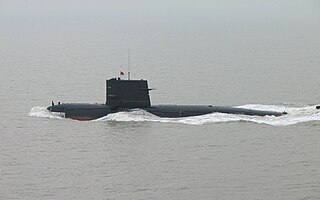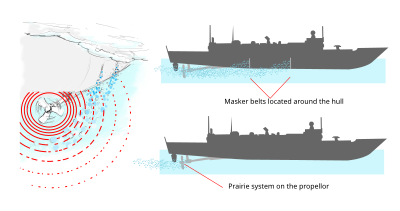
A submarine is a watercraft capable of independent operation underwater. It differs from a submersible, which has more limited underwater capability. The term is also sometimes used historically or colloquially to refer to remotely operated vehicles and robots, as well as medium-sized or smaller vessels, such as the midget submarine and the wet sub. Submarines are referred to as boats rather than ships irrespective of their size.

Sonar is a technique that uses sound propagation to navigate, measure distances (ranging), communicate with or detect objects on or under the surface of the water, such as other vessels.

A modern torpedo is an underwater ranged weapon launched above or below the water surface, self-propelled towards a target, and with an explosive warhead designed to detonate either on contact with or in proximity to the target. Historically, such a device was called an automotive, automobile, locomotive, or fish torpedo; colloquially a fish. The term torpedo originally applied to a variety of devices, most of which would today be called mines. From about 1900, torpedo has been used strictly to designate a self-propelled underwater explosive device.

The Permit-class submarine was a class of nuclear-powered fast attack submarines in service with the United States Navy from the early 1960s until 1996. They were a significant improvement on the Skipjack class, with greatly improved sonar, diving depth, and silencing. They were the forerunners of all subsequent US Navy SSN designs. They served from the 1960s through to the early 1990s, when they were decommissioned due to age. They were followed by the Sturgeon and Los Angeles classes.

An electronic countermeasure (ECM) is an electrical or electronic device designed to trick or deceive radar, sonar, or other detection systems, like infrared (IR) or lasers. It may be used both offensively and defensively to deny targeting information to an enemy. The system may make many separate targets appear to the enemy, or make the real target appear to disappear or move about randomly. It is used effectively to protect aircraft from guided missiles. Most air forces use ECM to protect their aircraft from attack. It has also been deployed by military ships and recently on some advanced tanks to fool laser/IR guided missiles. It is frequently coupled with stealth advances so that the ECM systems have an easier job. Offensive ECM often takes the form of jamming. Self-protecting (defensive) ECM includes using blip enhancement and jamming of missile terminal homers.

The baffles is the area in the water directly behind a submarine or ship through which a hull-mounted sonar cannot hear. This blind spot is caused by the need to insulate the sonar array, commonly mounted near the bow, from the noise of the vessel's machinery.

A stealth ship is a ship that employs stealth technology construction techniques in an effort to make it harder to detect by one or more of radar, visual, sonar, and infrared methods.

A towed array sonar is a system of hydrophones towed behind a submarine or a surface ship on a cable. Trailing the hydrophones behind the vessel, on a cable that can be kilometers long, keeps the array's sensors away from the ship's own noise sources, greatly improving its signal-to-noise ratio, and hence the effectiveness of detecting and tracking faint contacts, such as quiet, low noise-emitting submarine threats, or seismic signals.

The Carderock Division of the Naval Surface Warfare Center is one of eight Naval Sea Systems Command (NAVSEA) Surface Warfare Centers. The headquarters, located in Carderock, Maryland, includes the historic David Taylor Model Basin. The division includes remote sites across the United States concentrating on engineering, testing and modelling ship and ship's systems for the Navy. It has about 3,200 scientists, engineers, and support personnel working in more than 40 disciplines from fundamental science to applied and in-service engineering.

Anti-submarine warfare is a branch of underwater warfare that uses surface warships, aircraft, submarines, or other platforms, to find, track, and deter, damage, or destroy enemy submarines. Such operations are typically carried out to protect friendly shipping and coastal facilities from submarine attacks and to overcome blockades.

The Type 039 submarine is a class of diesel-electric submarines of the People's Liberation Army Navy. The class is the first diesel-electric submarine to be fully developed within China and also the first Chinese diesel-electric submarine to use the teardrop hull shape.

MILGEM project is a national warship program of the Republic of Turkey. Managed by the Turkish Navy, the project aims at developing multipurpose corvettes, frigates and destroyers that can be deployed in a range of missions, including reconnaissance, surveillance, early warning, anti-submarine warfare, surface-to-surface and surface-to-air warfare, and amphibious operations.
The term acoustic signature is used to describe a combination of acoustic emissions of sound emitters, such as those of ships and submarines. In addition, aircraft, machinery, and living animals can be described as having their own characteristic acoustic signatures or sound attributes, which can be used to study their condition, behavior, and physical location.
An acoustic mine is a type of naval mine which monitors audio activity in its vicinity. Depending on its design, it will either passively listen to its environment, depending only on the noise that is made by passing ships or actively send out audio pulses, not unlike a sonar, listening to the lapse in time in which the echo returns to it.

Underwater acoustics is the study of the propagation of sound in water and the interaction of the mechanical waves that constitute sound with the water, its contents and its boundaries. The water may be in the ocean, a lake, a river or a tank. Typical frequencies associated with underwater acoustics are between 10 Hz and 1 MHz. The propagation of sound in the ocean at frequencies lower than 10 Hz is usually not possible without penetrating deep into the seabed, whereas frequencies above 1 MHz are rarely used because they are absorbed very quickly.
Geophysical MASINT is a branch of Measurement and Signature Intelligence (MASINT) that involves phenomena transmitted through the earth and manmade structures including emitted or reflected sounds, pressure waves, vibrations, and magnetic field or ionosphere disturbances.
Acoustic quieting is the process of making machinery quieter by damping vibrations to prevent them from reaching the observer. Machinery vibrates, causing sound waves in air, hydroacoustic waves in water, and mechanical stresses in solid matter. Quieting is achieved by absorbing the vibrational energy or minimizing the source of the vibration. It may also be redirected away from the observer.
Silent running is a stealth mode of operation for naval submarines. The aim is to evade discovery by passive sonar by eliminating superfluous noise: nonessential systems are shut down, the crew is urged to rest and refrain from making any unnecessary sound, and speed is greatly reduced to minimize propeller noise. The protocol has been in use since the latter part of World War I, when hydrophones were invented to detect U-boats.
German submarine U-480 was an experimental Kriegsmarine Type VIIC U-boat of World War II.

INS Kadmatt (P29) is the second of four anti-submarine warfare corvettes built for the Indian Navy by the Garden Reach Shipbuilders and Engineers of Kolkata under Project 28. She was inducted into the Eastern Naval Command of the Indian Navy.














